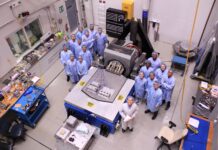If you’ve ever needed an X-ray or an MRI, you know that getting a glimpse inside the human body can be uncomfortable, time consuming, and expensive. However, one researcher at the Research Institute for Aging has developed a way to make some of that monitoring much easier.
Robert Amelard, a PhD candidate at the University of Waterloo, developed the Coded Hemodynamic Imaging System (CHIS), a touchless blood-monitoring device. “Touchless” means no part of the device comes into contact with the patient; it is no more invasive than being photographed. Based on current knowledge of how near-infrared light — which is able to penetrate the skin — interacts with blood, the device uses light and a camera to monitor blood flow. The light, which Amelard described as “the kind of light that you would experience if you go outside on a sunny day,” is shined on the patient. The camera, which is equipped with a filter to only pick up near-infrared light, captures data on how much light is being bounced back.
“If you shine light at intensity 100 and you see it come back in intensity 70, that tells you that some of the light has been absorbed by the amount of blood that’s been in there. And if it goes from 70 down to 50 and then back to 70, then you know that you’ve seen a blood pulse,” Amelard said.
CHIS is able to gather data about blood flow throughout an individual’s entire body based on light absorption, which is then automatically processed by a computer.
“You can infer so much of your health status through how your heart and how your blood is working throughout these systems,” he said. According to Amelard, being able to monitor the entire body at once provides more useful information than single point monitoring with a finger clip. Similarly, he explained that since CHIS relies on light, it also poses no risk to the patient.
Amelard explained that one of the major functions he foresees for this device is improving health care for seniors. Falls due to dizziness can be very serious, so the device, upon noticing decreased bloodflow to the head, could send an advance warning that the patient is at risk.
CHIS is also capable of scanning multiple people in one room. While less detailed information about each individual would be collected, Amelard described it as “a tradeoff.” When monitoring a group of people, the device would pick up information about the people’s heart rates rather than detailed blood flow patterns. In a senior’s care facility dining room, for example, noticing a suddenly elevated heart rate could give care providers advanced warning that an individual may need help.
Though CHIS could perform constant monitoring, Amelard explained that since information is processed automatically, it does not pose a privacy concern.
“This isn’t like security surveillance. There’s nobody at the other side watching people as they sleep,” Amelard said. “You could put the data onto a USB drive … and then the doctor has more information by which to make certain diagnosis. But at the end of the day there’s nobody watching you and your privacy is maintained.”
In addition to helping seniors, it may be valuable for monitoring patients where the familiar finger clip monitors are a problem, such as burn victims and premature infants. These special cases aside, Amelard said the device is useful for any patient undergoing long-term monitoring.
“If we were to wear a finger clip … for an extended period of time, it’s going to be cutting off circulation. If you have delicate skin it might be causing some rashes or abrasions,” Amelard said. According to him, since CHIS is touchless, “you don’t have to be worrying about elongated stresses” that contact-based devices cause.
Ultimately, Amelard envisions CHIS as part of a shift towards preventative medicine.
“I think that our healthcare system is top notch in terms of treatment plans. It’s just that acute care, treating a [blood vessel] blockage after it’s already blocked, it’s very expensive, it’s very timely, [and] the recuperation period is often quite lengthy. The big question then is can we be mitigating these, or preventing these in the first place?” he asked.
As a long-term monitoring system, the device could detect changes in the body before an individual feels a symptom.
“Once a physical symptom has happened, that means a lot may have already gone on under the surface that has gone undetected,” Amelard said. Monitoring blood flow could let a doctor “see if there’s something happening that may eventually lead to something worse, like a heart attack, but that we can prevent … with something like changing your diet.”
The device is currently a functional prototype. It could be tailored for a number of uses and is being tested with different kinds of light and filters, but Amelard believes a product for home monitoring could be ready for manufacturing within a few years.

































